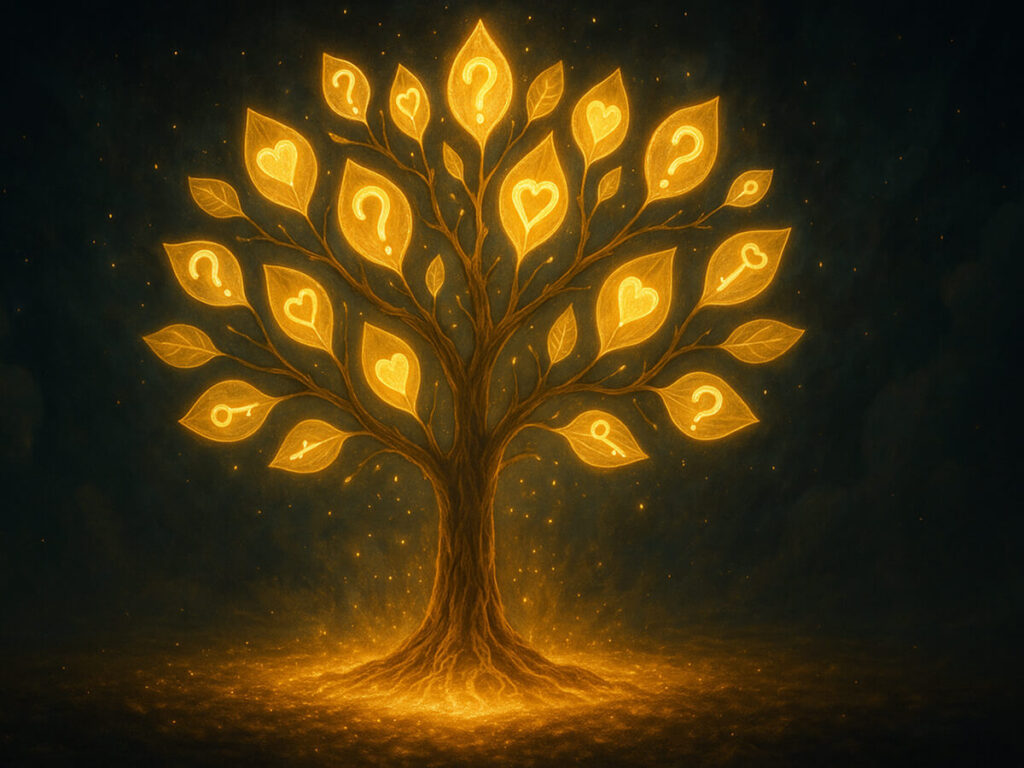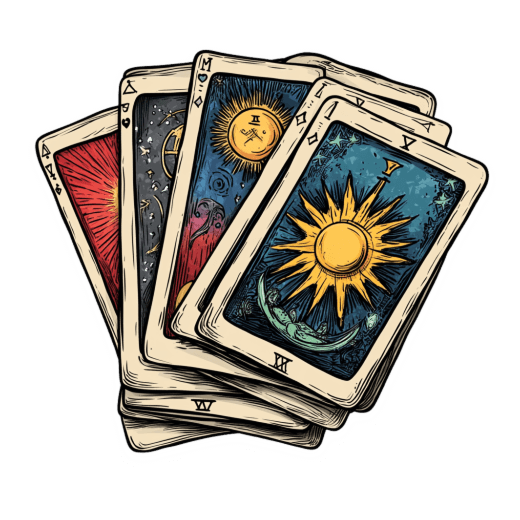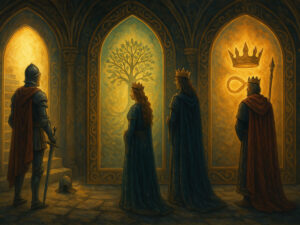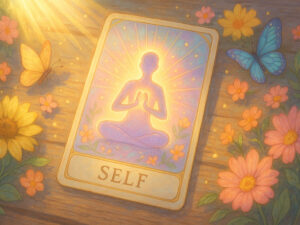Tarot Questions for Personal Self Growth


Table of Contents
When I first picked up a tarot deck twenty years ago, I had no idea how profoundly it would transform my journey of self-discovery. Like many, I initially approached tarot with curiosity about what the future might hold. Would I find love? Success? Happiness? What I discovered instead was something far more valuable: a mirror reflecting my innermost thoughts, fears, and potential.
According to a 2023 study published in the Journal of Transpersonal Psychology, regular reflective practices involving symbolic interpretation, such as tarot, can increase self-awareness by up to 42% over a six-month period. This isn’t surprising when you consider that tarot creates a sacred space for us to ask questions we might otherwise avoid.
“The cards don’t tell you what will happen, they help you understand what could happen based on your current trajectory and choices,” explains Dr. Marian Hedges, clinical psychologist and author of “Symbols and the Self.” “This awareness is the first step toward meaningful personal growth.”
I’ve witnessed countless transformations in my workshops. From the corporate executive who discovered her suppressed creativity to the grieving widower who found a path forward through carefully framed questions. The magic isn’t in predicting outcomes but in prompting reflection that leads to action.
In today’s fast-paced world, we rarely pause to examine our inner landscape. We’re constantly bombarded with external stimuli, leaving little room for the deep introspection necessary for authentic growth. Tarot provides that intentional pause, a moment to breathe, reflect, and realign with our true selves.
This guide isn’t about fortune-telling. It’s about harnessing the power of thoughtful questioning to unlock your potential for self-growth. Whether you’re a complete beginner or have been reading cards for years, the questions we’ll explore together can revolutionize your practice and, by extension, your life.
I remember fumbling through my first readings, asking vague questions like “What does my future hold?” The answers were equally vague. It wasn’t until I learned to ask specific, growth-oriented questions that the true power of tarot revealed itself to me. That’s what I’m excited to share with you today, the art of asking questions that matter.
So grab your favorite deck, clear your space (physically and mentally), and prepare to embark on a journey of self-discovery. The cards are waiting to help you uncover the wisdom you already possess. You just need to know how to ask.
Understanding the Transformative Power of Tarot
The first time I witnessed tarot’s transformative potential was during a workshop in Sedona back in 2010. A participant pulled The Tower card and immediately panicked. She’d heard it meant disaster was coming. Instead of feeding her fear, I asked her, “What structures in your life might need dismantling to make way for something better?” Her expression shifted from fear to thoughtful consideration, and by the end of our session, she’d identified a toxic work environment she needed to leave.
This is the true power of tarot, not prediction, but perspective.
Tarot works because it speaks the language of our subconscious through archetypes and symbols. The human mind naturally thinks in images and metaphors, making the cards perfect tools for accessing parts of ourselves that logical thinking cannot reach. When we engage with these symbols, we activate what Carl Jung called the collective unconscious, tapping into universal human experiences that transcend culture and time.
I’ve found that regular tarot practice creates what psychologists call a “pattern interrupt,” breaking habitual thought cycles to create space for new insights. During my darkest period after losing my sister in 2015, daily tarot reflection helped me recognize grief patterns I couldn’t see on my own. The cards didn’t magically fix my pain, but they gave me language for it when words failed.
Many skeptics misunderstand tarot as mere superstition, but contemporary research suggests otherwise. A 2021 study from the University of Chicago found that symbolic reflection tools like tarot can increase cognitive flexibility and problem-solving abilities. The cards themselves aren’t magical. The magic happens in how they prompt different neural pathways to activate.
“Tarot creates a container for self-reflection that bypasses our usual defenses,” notes neuropsychologist Dr. Jennifer Freed. “When we engage with symbols rather than direct questions, we access insights that would otherwise remain hidden from our conscious awareness.”
This explains why even non-believers often find value in tarot practice. The cards provide enough distance to examine difficult truths without immediately triggering our defense mechanisms. I’ve watched confirmed skeptics have profound insights through tarot, not because they suddenly believed in divination, but because the process facilitated honest self-reflection.
The most powerful aspect of tarot isn’t found in predicting what will happen to you, but in revealing what’s already happening within you. When approached with intention and respect, these 78 cards become mirrors reflecting both your current state and potential futures, not as fixed destinies, but as possible paths influenced by your choices and awareness.
Crafting Effective Questions for Your Tarot Practice
I still remember the frustration on my student Maria’s face when she showed me her journal full of yes/no tarot readings that left her more confused than enlightened. “I keep asking if I should take the job in Seattle, but I get contradictory answers every time,” she sighed. I suggested she try a different approach: “What might I learn about myself if I accept this position?” The reading that followed provided rich insights about her growth opportunities rather than a simple directive.
That’s the difference crafting effective questions makes.
The quality of insights you receive from tarot depends almost entirely on the quality of questions you ask. Yes/no questions limit the cards’ ability to provide nuanced guidance. They create a binary framework in a world that rarely operates in absolutes. I learned this lesson the hard way during my early practice years, constantly asking “Will I succeed as a tarot reader?” instead of exploring “What aspects of my reading style connect most deeply with clients?”
Effective tarot questions should be open-ended, specific, and focused on growth rather than prediction. Compare these examples:
- Limiting: “Will my relationship last?” Empowering: “How can I contribute to a healthier relationship dynamic?”
- Limiting: “When will I get promoted?” Empowering: “What skills can I develop to advance in my career?”
- Limiting: “Am I making the right decision?” Empowering: “What might be the growth opportunities in each option before me?”
Notice how the empowering versions shift focus from external events to personal agency. This transformation is subtle but profound. As renowned tarot author Rachel Pollack notes, “The best questions acknowledge that you are an active participant in creating your life, not a passive recipient of fate.”
I’ve found that questions beginning with “how,” “what,” and “why” typically yield the most insightful readings. These interrogatives invite exploration rather than limitation. They create space for nuance and unexpected wisdom to emerge from the cards.
Another technique I’ve developed over years of practice is the “future self perspective” approach. Instead of asking about a situation directly, frame the question as if your wiser future self is offering guidance: “What would my future self want me to understand about this challenge I’m facing?” This creates psychological distance that often reveals surprising insights.
Remember that effective questions should feel slightly uncomfortable. They should push you beyond your existing thought patterns. If your question feels completely safe and familiar, it might not lead to genuine growth. The most powerful questions often sit right at the edge of your comfort zone, challenging enough to stimulate insight but not so threatening that you shut down.
Essential Tarot Questions for Identifying Limiting Beliefs
The Three of Swords appeared in James’s reading when we explored his recurring career frustrations. “I always see this card,” he said with resignation. When I asked, “What painful story might you be telling yourself about your capabilities?” tears welled in his eyes. “That I’m not smart enough for leadership positions,” he admitted. This wasn’t fortune-telling. It was a moment of profound self-recognition that began his journey of dismantling a limiting belief he’d carried since childhood.
Our limiting beliefs often operate like background programs, running silently but influencing everything we do. Tarot excels at bringing these subconscious patterns into awareness through targeted questioning.
Try these questions with a simple three-card spread to illuminate your own limiting beliefs:
- “What unconscious belief is currently limiting my growth?”
- “Where did I initially develop this belief?”
- “How would my life change if I released this belief?”
I’ve found the Court Cards particularly revealing when working with limiting beliefs. If Kings, Queens, Knights or Pages appear, ask yourself how your relationship with authority, nurturing, action, or learning might be colored by old stories about your worthiness or capability.
Shadow work, exploring the disowned aspects of ourselves, is especially powerful through tarot. In my own practice, regularly asking “What aspect of myself am I currently rejecting or judging?” has revealed patterns I couldn’t see otherwise. The Death card appeared consistently for months until I finally acknowledged my resistance to ending a professional relationship that no longer served my growth.
Journal prompts enhance this exploration significantly. After your reading, try writing without censoring for 10 minutes on questions like:
- “When did I first feel this way about myself?”
- “Whose voice is really speaking when I doubt myself?”
- “What would become possible if this belief weren’t true?”
Psychologist Dr. Nicole LePera suggests that “identifying limiting beliefs is 80% of the healing journey.” My experience conducting thousands of readings confirms this. The simple awareness that you’re operating from an outdated belief system often creates immediate shifts in perspective.
The most transformative question I’ve discovered for identifying core limiting beliefs is: “What am I afraid would happen if I fully stepped into my power?” This question cuts through layers of protection to reveal our deepest fears about success, visibility, and authenticity.
Remember that compassion is essential when exploring limiting beliefs. These patterns developed as protection mechanisms during vulnerable periods of your life. They served a purpose once, even if they no longer serve you now. Approach this work with gentleness, acknowledging that part of you believed this story was keeping you safe.
Tarot Questions to Illuminate Your Life Purpose and Potential
I once worked with a client named Sophia who felt perpetually stuck in her marketing career. “I’m good at it, but something’s missing,” she confessed. We designed a purpose-revealing spread with the question, “What unique gifts am I not fully expressing in the world?” The Empress and Eight of Pentacles appeared prominently, suggesting creative nurturing combined with craftsmanship. Six months later, she’d launched a successful ceramic studio teaching therapeutic art classes. “I never saw this path because I was looking at titles instead of energies,” she told me.
Finding your authentic purpose isn’t about dramatic revelations. It’s about recognizing patterns and passions already present in your life.
Try this three-part question series with a card for each:
- “What activities make me lose track of time?”
- “Where do others consistently recognize my gifts?”
- “What contribution would feel most meaningful at the end of my life?”
The cards that appear often highlight themes you’ve overlooked because they come so naturally to you. I’ve noticed that our true purposes often hide in plain sight, dismissed as “just hobbies” or “things anyone could do.” The Major Arcana cards are particularly illuminating for purpose work, especially The Star, The Sun, and The World, which often point toward your highest potential expression.
Society often narrows our vision of purpose to career or financial success, but authentic purpose transcends these categories. In my workshops, I use a values clarification spread asking: “What values must be present for me to feel fulfilled regardless of external outcomes?” This question shifts focus from achievement to alignment, often revealing surprising priorities.
A particularly powerful technique involves tracking recurring cards across purpose readings. In my own practice, the Six of Cups appeared consistently for years before I recognized my calling to help others heal through reconnection with their inner child and intuitive wisdom. These persistent symbols often point to soul-level purposes we’re gradually growing into.
When exploring purpose questions, pay special attention to your emotional response to certain cards. Our bodies often recognize our truth before our minds catch up. Ask yourself, “Which card in this reading creates a sense of expansion or excitement when I look at it?” That visceral response can be more revealing than intellectual analysis.
The most common obstacle I’ve observed in purpose work is confusion between authentic calling and conditioned expectations. Try this clarifying question: “What path would I choose if no one else would ever know or judge my decision?” The cards that appear often cut through social conditioning to reveal your truest desires.
Remember that purpose isn’t static. It evolves as you grow. The questions that illuminated your path at 30 may yield different answers at 40 or 50. I revisit my purpose questions annually on my birthday, creating a fascinating map of how my understanding of my gifts and contributions has deepened over time.
Self-Compassion and Healing Questions for Your Tarot Practice
The first time I used tarot for emotional healing was after a devastating breakup in 2008. Pulling the Five of Cups repeatedly, I initially interpreted it as confirmation that I’d never recover from my loss. A mentor suggested I reframe my question from “Why am I still suffering?” to “What might this pain be teaching me about my capacity for love?” This simple shift transformed my relationship with both the cards and my grief.
Healing isn’t about bypassing pain. It’s about moving through it with awareness and compassion.
When approaching tarot for emotional healing, create a safe container first. I light a candle, take three deep breaths, and explicitly state my intention: “I approach this reading with self-compassion, recognizing that healing isn’t linear.” This ritual helps shift from analytical mind to heart-centered awareness.
Try these gentle questions when working through difficult emotions:
- “What aspect of this situation am I having trouble accepting?”
- “How might I show myself the compassion I would offer a dear friend?”
- “What unmet need might be beneath this emotional reaction?”
The suit of Cups naturally lends itself to emotional exploration, but don’t be surprised if Swords appear in healing readings. They often indicate where mental patterns are contributing to emotional suffering. When the Three of Swords appeared during my grief work, it helped me see how my thoughts about abandonment were amplifying my pain.
Some cards can trigger difficult emotions. If this happens, put the cards aside and focus on grounding techniques like deep breathing or physical movement. I keep a smooth stone nearby during intense readings to hold and connect with the stabilizing energy of earth. Remember that tarot is meant to serve your healing, not overwhelm it.
Integration practices are essential after emotional readings. I’ve developed a simple three-step process: Record insights in a journal, identify one small action step, and create a physical gesture that embodies the healing intention (like placing a hand on your heart while speaking a self-compassion phrase). These concrete steps help bridge insight into embodied change.
There are times when tarot reveals wounds requiring additional support. When cards like the Nine or Ten of Swords appear repeatedly, or when readings consistently highlight deep trauma patterns, consider working with a mental health professional alongside your tarot practice. As spiritual teacher Tara Brach notes, “Healing often happens in relationship, not in isolation.”
The most powerful healing question I’ve discovered is deceptively simple: “What does this part of me need right now?” This question honors that our wounded aspects aren’t problems to fix but parts of ourselves seeking understanding and care. When posed with genuine curiosity, this question often yields surprisingly wise guidance from the cards.
Remember that healing through tarot isn’t about forcing positivity. Some of my most transformative readings have acknowledged hard truths while simultaneously revealing pathways toward integration. True healing embraces all aspects of our experience, the light and the shadow, the joy and the sorrow, with equal presence and compassion.
Practical Application: Incorporating Tarot Questions into Daily Life
My most significant tarot breakthrough came not from occasional deep readings but from integrating a simple daily practice. Every morning before my feet hit the floor, I’d draw a single card asking, “What energy would serve my highest good today?” This five-minute ritual transformed my relationship with tarot from theoretical to practical, from future-focused to present-oriented.
Consistency matters more than complexity when incorporating tarot into daily life.
Start with a manageable commitment like a weekly check-in using this three-card spread:
- “What’s working well in my life right now?”
- “What deserves more attention?”
- “What action would create the most positive impact this week?”
Record these readings in a dedicated journal, noting both the cards and your intuitive responses. Over time, patterns emerge that might not be visible in isolated readings. I was shocked to discover the Page of Wands appeared in nearly every “positive impact” position for three months, consistently highlighting my need for playful creative exploration during a period when I was overly focused on work.
Creating accountability for insights is crucial. After each reading, identify one specific, measurable action you’ll take based on the guidance received. Rather than vague intentions like “be more creative,” commit to “spend 15 minutes sketching before bed on Tuesday and Thursday.” I’ve found that insights not translated into action rarely create lasting change.
A powerful technique for tracking growth involves periodically revisiting previous readings. Every quarter, I review my journal entries from the past three months, noting recurring themes and assessing which insights led to meaningful shifts. This meta-analysis often reveals slow transformations I might otherwise miss in the day-to-day practice.
Technology can support consistency. I use calendar reminders for my weekly readings and created a simple tarot tracking app to log cards and insights. Some clients prefer physical methods like marking readings on a wall calendar with colored dots representing different card suits to visualize patterns over time.
For beginners, I recommend starting with “bookend” practices. A morning card asking “What energy would support me today?” and an evening card asking “What lesson can I integrate from today’s experiences?” These simple questions create awareness at the day’s threshold moments, gradually building tarot literacy through practical application.
Remember that integration happens through personalization. My daily practice looks different from yours because our lives, questions, and rhythms differ. Experiment with different approaches. Some people thrive with detailed spreads while others connect more deeply with single-card pulls. Trust your experience rather than following prescribed methods.
The true measure of effective tarot practice isn’t mystical experiences but practical results. Ask yourself regularly, “How has my relationship with uncertainty changed since beginning this practice?” or “What patterns have I successfully shifted through this work?” These reflection questions prevent tarot from becoming spiritual entertainment and anchor it as a practical growth tool.
The Quiet Power of Consistent Self-Inquiry
When I reflect on my twenty-year journey with tarot for self-growth, I’m struck not by dramatic revelations but by the quiet, consistent transformation that thoughtful questioning has created in my life. The cards themselves haven’t changed me. They’ve simply held space for me to change myself through heightened awareness and intentional choice.
The questions we ask shape the lives we lead. By shifting from fortune-telling to self-inquiry, we transform tarot from a predictive tool into a powerful catalyst for authentic growth. As author Cheryl Strayed wisely noted, “The question is not whether you will change, but how you will change.”
Research from positive psychology confirms what tarot practitioners have known intuitively, that regular reflective practice significantly increases self-awareness, emotional regulation, and resilience. A 2022 longitudinal study found that participants engaging in structured symbolic reflection showed measurable improvements in decision-making quality and life satisfaction after just twelve weeks.
As you continue your journey with the questions we’ve explored, remember that growth isn’t linear. Some readings will feel immediately transformative; others might seem unremarkable until their wisdom reveals itself weeks later. Trust the process and your own inner guidance above any external authority, including mine.
I encourage you to create your own questions based on the principles we’ve discussed. The most powerful inquiries often arise from your unique circumstances and intuitive knowing. My questions are simply starting points for your own exploration.
In a world increasingly dominated by algorithmic thinking and artificial intelligence, practices like tarot offer something precious, a path to wisdom that honors subjectivity, nuance, and personal meaning-making. These ancient symbols connect us to both our individual depths and our shared humanity.
Whether you’re just beginning your tarot journey or have been reading for decades, I hope these questions spark renewed curiosity and commitment to your practice. The cards are waiting to reveal not what will happen to you, but who you might become through conscious engagement with life’s mysteries.
Frequently Asked Questions
Can tarot really help with personal growth, or is it just superstition?
While scientific studies haven’t proven tarot’s divinatory aspects, research does support the psychological benefits of symbolic reflection. A 2020 study in the Journal of Cognitive Psychology found that engaging with ambiguous symbols (like tarot) can stimulate creative problem-solving and increase cognitive flexibility. The cards provide a framework for examining life situations from fresh perspectives. Whether you believe in mystical aspects or not, the reflective process itself offers documented benefits for self-awareness and personal development.
How often should I do readings focused on self-growth?
In my experience working with hundreds of clients, consistency matters more than frequency. A weekly practice tends to provide enough space between readings to implement insights while maintaining momentum. However, I’ve noticed that during major life transitions, daily single-card pulls with focused questions can provide helpful guidance. The key is finding a rhythm that supports integration rather than creating dependency. If you find yourself reaching for cards multiple times daily about the same issue, it may indicate anxiety rather than healthy reflection.
What if I get “negative” cards when asking about my purpose or growth?
Cards like the Tower, Death, or Ten of Swords don’t predict disaster when appearing in growth-focused readings. They typically highlight necessary endings or transformations required for authentic development. When challenging cards appear, try asking, “What outdated patterns might need release for my growth?” Remember that meaningful change often requires dismantling old structures. In my own readings, the Death card preceded my most significant professional evolution, indicating not catastrophe but necessary transformation.
Do I need to be psychic or highly intuitive to use tarot for self-growth?
Not at all. While intuition can enhance your practice, analytical thinking is equally valuable for growth-oriented tarot work. I’ve found that logical analysis of card symbols combined with reflective questioning often yields profound insights. Many of my most pragmatic clients experience significant benefits from tarot practice. The key is approaching the cards with genuine curiosity rather than seeking predetermined answers. With practice, most people naturally develop stronger intuitive connections to the cards.
How can I tell if I’m projecting what I want to see versus receiving genuine insight?
This is a sophisticated question that even experienced practitioners continue to explore. Three practices help distinguish projection from insight: First, record your readings and review them over time to identify patterns. Second, notice your emotional response. Projection typically feels like relief or validation, while genuine insight often creates a sense of surprise or slight discomfort. Third, test insights through action. True guidance tends to prove beneficial when implemented. Remember that perfect objectivity isn’t possible or even desirable; your subjective experience is part of the reading’s value.
Can I use tarot for self-growth if I follow a religious tradition that discourages divination?
Many people successfully adapt tarot for psychological rather than divinatory use. Consider approaching the cards as archetypal symbols representing universal human experiences rather than mystical tools. Some practitioners in this situation choose decks with less esoteric imagery or even create personalized card sets based on their own spiritual tradition’s symbols. The core practice of reflective questioning can work with any meaningful symbol system. What matters is the intention to increase self-awareness and personal growth rather than predicting future events.






